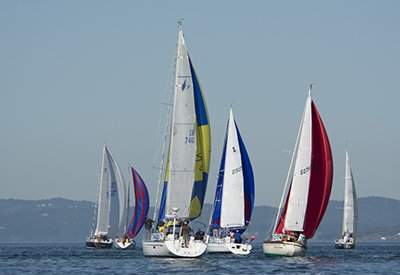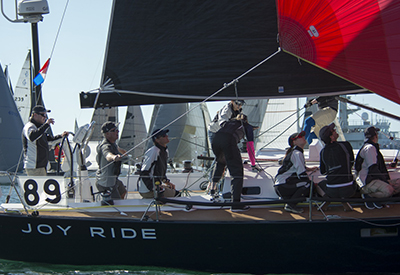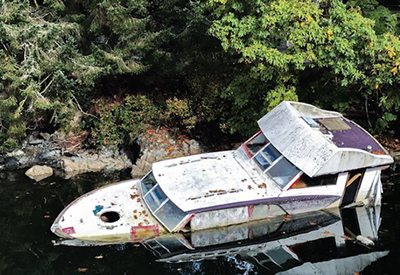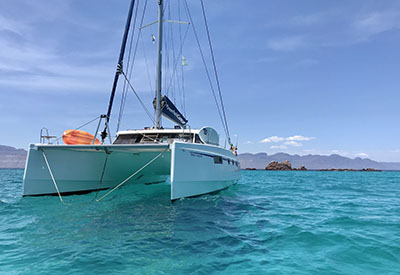Downwind Starts for the Long Distance Fleet

Mar 12, 2020
By Alex Fox
Photos by Jill Fitz Hirschbold Photography
Many articles speak to the challenges and strategies involved in achieving a good upwind start, however, they often begin with sheets eased or with spinnakers ready to hoist, so let’s dig into some of the considerations that come into play with these types of starts.
Top Ten list:
1) Lead back, for control: One of the first things that comes to mind here, is that leading the fleet to the line gives one more control. As the boat ahead, you can maneuver more freely, set the pace and adjust your own timing. The trailing boat, on the other hand, may be held up by the boats ahead, luffing up, getting in the way etc. A second point, I’d much rather be a little early and have to kill, than be late with no way to get there from here.
2) Formulate a plan: Downwind starts will often require a spinnaker hoist, so it’s important that the whole crew understands what the plan is. Here’s an example; “Plan is to start mid-line on port…approach a bit early with genoa…Turtle set up to starboard…may have to luff up a bit to kill…Let’s set the pole at 1 minute, preset guy…Likely hoist with five seconds to go…Make sure to jump the halyard…Everyone know their jobs?”
3) Know your rights: The basic right of way rules apply and it’s important to know when you’re the right away or give way vessel. Port/Starboard, Windward/Leeward, Overtaking/Clear ahead, these are the three criteria in this order. Eyes out of the boat, talking about potential coming togethers, making sure that a part of the conversation is about possible actions. Example; “After the hoist we’ll be on port…not sure that we’ll get across Raven…so, everyone be ready for a possible gybe.”
4) Bow Person: In the pre-start, especially once the genoa or jib is up, it’s really important to have a bow look out. The most important part of this, is to have good communication between the bow person and the helm. Hand signals are fine, but be sure to clarify what they mean. Either the bow man’s pointing at another boat or they’re pointing to the clear path. Verbalizing the information is always going to be good too. If you’re the bow person, make sure you understand what the helm is looking for.
5) Hoist or delay?: In a downwind start, there are arguments to be made for both, hoisting as soon as possible or delaying the hoist. The biggest benefit of hoisting asap, is of course increased speed, but on the cost side of the ledger, there might be a brief slow down period or reduced maneuverability. Make sure you’re not compromising your clear air or creating a risky right of way situation by hoisting too early.
 6) Proper Headsail lead: In a reaching start, no spinnaker, make sure you’ve adjusted your genoa or jib lead outboard and forward. The upwind car position will not be right when cracked off on to a close or a beam reach. Barber hauling outboard will have a huge effect on boat speed when white sail reaching. General rule of thumb, for every inch outboard, the lead goes forward an inch. The idea is to maintain a parallel slot with the leach of the mainsail. The telltales on the genoa luff should break relatively evenly.
6) Proper Headsail lead: In a reaching start, no spinnaker, make sure you’ve adjusted your genoa or jib lead outboard and forward. The upwind car position will not be right when cracked off on to a close or a beam reach. Barber hauling outboard will have a huge effect on boat speed when white sail reaching. General rule of thumb, for every inch outboard, the lead goes forward an inch. The idea is to maintain a parallel slot with the leach of the mainsail. The telltales on the genoa luff should break relatively evenly.
7) Favoured End: In upwind starts, the end of the line that’s further upwind is generally favored. Conversely, in a Downwind start, the end that’s furthest downwind should be favoured, right? Now that statement has a proviso, as in, clear air is always the top priority. Managing to achieve both would be pretty awesome, but favoured by wind direction, will sometimes take a back seat. Usually there’s a best compromise, which includes clear air and close to the favoured end.
8) Speed is King: Getting away from the fleet in a downwind start, will often be determined by who gets up to speed the soonest. Due to the time it may take to hoist, the requirements of dealing with traffic, or the fact that some will get involved in mini luffing battles, in effect slowing each other down, there’s a great opportunity for those who can get up to speed and extend away from the fleet. So, focus, don’t over-trim find the right angle, get the weight in the right place and sail fast!
9) Behind may bring advantage: If the wind is quite far aft at the start, this indeed gives some potential advantage to the trailing boat. Clear air, first and foremost, will provide the opportunity to sail at maximum speed, plus you’ll have the luxury of choice to point the bow where you want. Maybe that means positioning your wind shadow on the boat ahead or just hinting at it, so they sail all over, reacting and avoiding your dirt. Either way you’ve got control. A warning here, get to know your competition, and don’t mess with the Mad Luffer!
10) Line Density: The up side of starting away from the pack, may very well outweigh all other factors. Clear air, freedom to maneuver, less risk of altercation, less stress, these are the benefits. That sounds like a pretty good trade off to me. Just don’t give up too much distance to the fleet. So, the best solution, again, might be a compromise of starting away from the pack without giving up significant distance to the first mark or waypoint. Downwind starts, in my estimation, really add some flavour to the game. I hope these musings will constructively add to the conversation for you and your team.
See you out on the start line sometime soon.
Alex Fox is a winning Royal Victoria YC, Victoria BC racer and sailing specialist at Trotac Marine





























